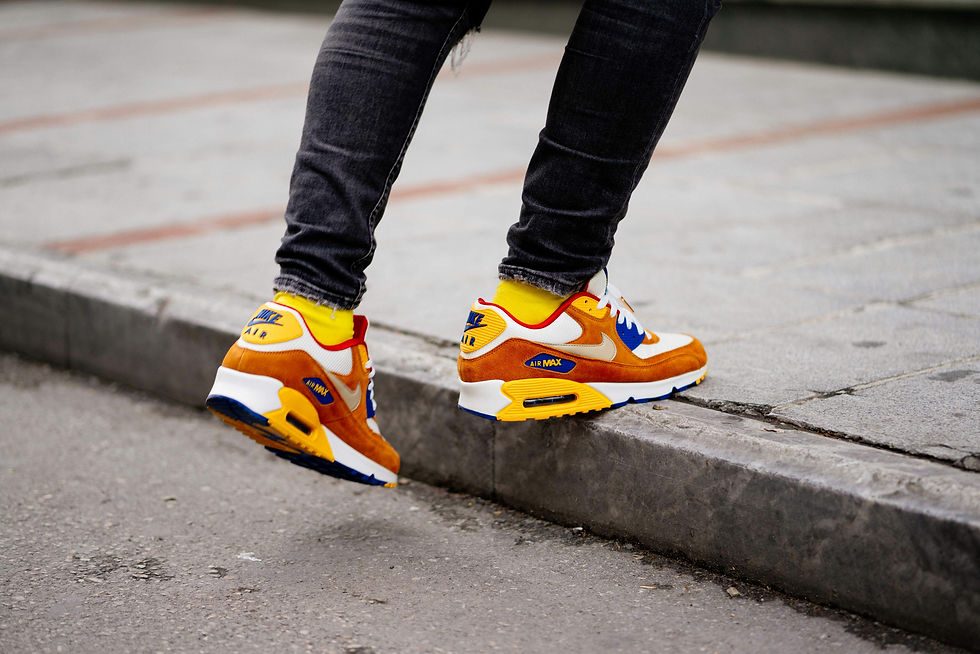Why Trainers Might Not Be the Best Choice as School Shoes
- Sam Chetwood

- Jul 10
- 3 min read
Trainers have become the go-to for many families, easy to get on, comfy to wear and often allowed for PE days at school. So it’s not surprising that more parents are asking, why not just let kids wear trainers every day? And some schools have started to relax the rules in response.
Here's my take on it from a foot health perspective... while the comfort and convenience of trainers are appealing, there are some important considerations when it comes to wearing them all day, every day, particularly for young, growing feet.

Comfort Comes in Different Forms
Most modern trainers are designed for sport, constructed to support high-impact activity like running, jumping and quick changes of direction. To do this, they often feature:
Cushioned soles
Raised heels
Toe spring (an upward curve at the front of the shoe)
Trainers may feel soft and springy underfoot, but that doesn’t make them a healthy choice for daily wear, especially when walking, standing and moving around a classroom is very different from playing sport.
What’s the Problem With Cushioned Soles?
Cushioned soles are designed to absorb shock during intense movement. But when worn for low-impact activity like walking, they can actually cause more harm than good.
Lazy feet: the foot’s muscles stop working as hard, leading to weakness over time.
Heavier impact: the extra padding encourages longer strides and firmer heel strikes, which can send shockwaves through the knees, hips and lower back, resulting in joint and muscle pains.
Postural changes: Raised heels and toe spring alter your natural walking pattern and hold the feet in an unnatural position, affecting balance, posture and alignment.
In short, wearing sports trainers all day can interfere with the natural biomechanics of walking and that’s particularly concerning for children whose movement patterns and posture are still developing.
What About the Toes?
Another hidden flaw in many trainers is the shape of the toe box. Most curve inwards or taper too tightly, restricting the toes’ ability to spread and grip. Over time, this can:
Weaken the arch
Reduce balance and stability
Increase the risk of problems like bunions and ingrown toenails
Children need room to wiggle their toes, not just for comfort, but to support healthy development.
Feet Need to Breathe
Most trainers are made from synthetic materials that don’t breathe well. This can create a warm, moist environment, the perfect breeding ground for bacteria. This can lead to sweaty, smelly feet and skin irritation.
The Real Issue is Fit
It’s also worth pointing out, not all leather school shoes are good for feet either! A poorly fitted shoe (whether it’s a formal style or a sporty one) can do more harm than good.
What matters most is:
The shape of the shoe (does it match the foot?)
The fit around the heel, instep and toes
The materials (are they breathable and flexible?)
Whether the shoe allows the foot to move naturally
Properly fitted school shoes should support natural movement, allow for growth and keep feet healthy throughout the school day.
What to Look for in a School Shoe
A flat sole with no heel rise
No toe spring – the sole should lie flat from heel to toe
A wide toe box so toes can spread naturally
Lightweight and flexible materials
A secure fit around the heel
Breathable uppers (ideally leather)
Adequate length, width and depth for your child’s foot
There are some trainer-style shoes designed specifically for school that tick many of these boxes but they’re quite different to the cushioned sports trainers found on the high street.
Trainers might be comfy, but they’re not always kind to feet, especially when worn every day. For growing children, whose feet, posture and movement patterns are still developing, the right school shoes can make a big difference.
By choosing footwear that allows their feet to move, flex and grow naturally, and ensuring it fits properly, you’re helping set them up for a lifetime of healthy movement.
If you’re unsure what’s right for your child, we’re here to help. Book a fitting or get in touch for expert advice.
School shoes fittings are available at: CeCe & Me Wandsworth, CeCe & Me Salisbury and CeCe & Me Bath



Comments